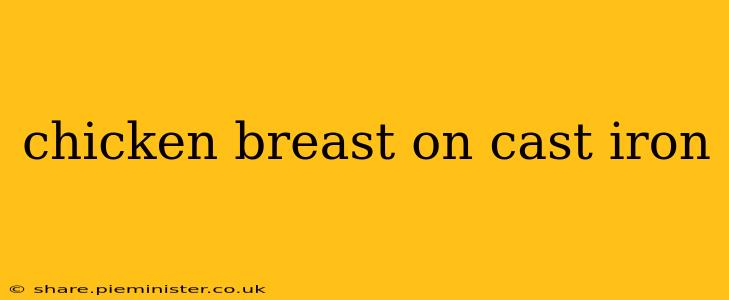Cast iron. The mere mention conjures images of rustic kitchens, sizzling meats, and that unmistakable, deeply satisfying sear. And when it comes to cooking chicken breast, cast iron delivers unparalleled results—a beautifully browned exterior and a juicy, tender interior. This guide will walk you through everything you need to know to master this classic cooking technique.
Why Cast Iron for Chicken Breast?
Cast iron's exceptional heat retention is key to its success with chicken. It sears the chicken beautifully, creating a delicious crust while ensuring even cooking throughout. Unlike non-stick pans, which can sometimes cause chicken to stick or steam, cast iron allows for proper browning and the development of complex flavors. The even heat distribution minimizes hot spots, preventing unevenly cooked chicken.
How to Cook Chicken Breast on Cast Iron: A Step-by-Step Guide
What you'll need:
- Cast iron skillet: Seasoned cast iron is ideal, but a well-maintained unseasoned skillet works too.
- Chicken breasts: Choose boneless, skinless breasts for even cooking.
- Oil: High-heat oils like avocado, canola, or grapeseed oil are best. Olive oil has a lower smoke point and isn't recommended for high-heat searing.
- Seasoning: Salt and freshly ground black pepper are essential. Consider adding garlic powder, onion powder, paprika, or other spices to enhance the flavor.
- Tongs: For safely handling the chicken.
- Meat thermometer: To ensure the chicken is cooked to a safe internal temperature.
Instructions:
-
Prepare the chicken: Pat the chicken breasts dry with paper towels. This helps them brown properly. Season generously with salt, pepper, and any other desired spices.
-
Heat the skillet: Place the cast iron skillet over medium-high heat. Add about 1-2 tablespoons of oil to the hot skillet. The oil should shimmer when it's ready.
-
Sear the chicken: Carefully place the chicken breasts in the hot skillet. Avoid overcrowding the pan; cook in batches if necessary. Sear for 3-4 minutes per side, until a beautiful golden-brown crust forms.
-
Reduce the heat: Once seared, reduce the heat to medium-low. Cover the skillet and continue cooking until the internal temperature reaches 165°F (74°C), about 10-15 minutes, depending on the thickness of the breasts.
-
Check for doneness: Use a meat thermometer to ensure the chicken is cooked through. Avoid cutting into the chicken to check for doneness, as this will release juices.
-
Rest the chicken: Once cooked, remove the chicken from the skillet and let it rest for 5-10 minutes before slicing and serving. This allows the juices to redistribute, resulting in a more tender and flavorful chicken breast.
Troubleshooting Common Issues
My chicken is dry.
This often happens when the chicken is overcooked. Use a meat thermometer to ensure it reaches 165°F (74°C) but no more. Also, letting the chicken rest after cooking is crucial for retaining moisture.
My chicken is sticking to the pan.
This is less likely with seasoned cast iron, but ensure your pan is adequately hot and oiled before adding the chicken. Don't overcrowd the pan either.
How long does it take to cook chicken breast on cast iron?
Cooking time depends on the thickness of the breasts and the heat level. Generally, it takes about 15-20 minutes total, including searing and cooking. Always use a meat thermometer to ensure the chicken reaches a safe internal temperature.
Can I cook other things in the same pan?
Absolutely! Cast iron is versatile. You can use the same pan to cook vegetables, sauté other meats, or even make a pan sauce with the delicious pan drippings left behind after cooking the chicken.
Beyond the Basics: Flavor Variations
Experiment with different marinades and seasonings to elevate your cast iron chicken breast game. Try a lemon-herb marinade, a spicy chipotle rub, or a classic garlic and parmesan seasoning. The possibilities are endless! Remember, the key is to master the foundational technique outlined above, then let your creativity flow. Enjoy!
